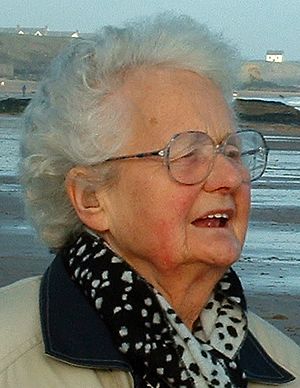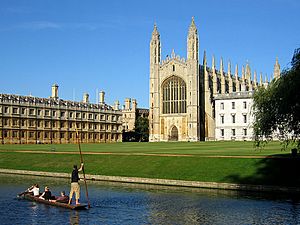Mary Midgley facts for kids
Quick facts for kids
Mary Midgley
|
|
|---|---|
 |
|
| Born |
Mary Scrutton
13 September 1919 London, England
|
| Died | 10 October 2018 (aged 99) Jesmond, Newcastle, England
|
| Alma mater | Somerville College, Oxford |
|
Notable work
|
Beast and Man (1978), Animals and Why They Matter (1983), Evolution as a Religion (1985), Science as Salvation (1992) |
| Spouse(s) | Geoffrey Midgley (m. 1950, d. 1997) |
| Awards | Honorary D. Litt (1995), Durham University; Honorary DCL (2008), Newcastle University |
| Era | Contemporary philosophy |
| Region | Western philosophy |
| School | Analytic philosophy |
|
Main interests
|
Moral philosophy, animal rights, philosophy of science, ethology, evolution |
|
Notable ideas
|
Humans as ethical primates |
|
Influences
|
|
Mary Beatrice Midgley (born Scrutton; September 13, 1919 – October 10, 2018) was an important British philosopher. She taught philosophy at Newcastle University. Mary Midgley was well-known for her ideas on science, ethics (which is about right and wrong), and animal rights.
She wrote her first book, Beast and Man, in 1978 when she was almost 60 years old. After that, she wrote more than 15 other books. Some of her famous works include Animals and Why They Matter (1983) and Evolution as a Religion (1985). She also wrote her life story, called The Owl of Minerva, in 2005.
Midgley believed that science should not replace other important subjects like art, history, and literature (called the humanities). She thought that philosophers could learn a lot from nature, especially from animals. She strongly argued that humans should be seen as a type of animal first and foremost. Mary Midgley also wrote about how philosophical ideas appeared in popular science books. She was known for challenging ideas she disagreed with.
Contents
Growing Up and Education
Mary Midgley was born in London, England. Her father was a chaplain at King's College, Cambridge. She grew up in different parts of England, including Cambridge.
She went to Downe House School, where she became very interested in Greek and philosophy. She decided to study Classics (ancient Greek and Roman studies) at university. She felt that English literature was something she could read on her own. She also learned that studying Classics at Oxford University meant she could also study philosophy. She loved the ancient Greek philosopher Plato and wanted to learn more.
In 1937, Mary Midgley got a place at Somerville College, Oxford. Before starting university, she tried to learn German in Austria. However, she had to leave early because of the difficult political situation there. At Oxford, she studied "Mods and Greats," which included Classics and philosophy. She graduated with top honors.
During her time at Oxford, many young men left to fight in World War II. This meant that for the first time, women students were the majority. Mary Midgley believed this was important. She felt it helped women philosophers like herself, Iris Murdoch, and Philippa Foot to be heard more.
Mary Midgley's Career
After finishing her studies in 1942, Mary Midgley worked for the government during the war. She also taught at schools. In 1947, she went back to Oxford to do more research. She started studying the ideas of the philosopher Plotinus but never finished her advanced degree. She later said she was "lucky" not to have gotten a doctorate. She felt that while doctorates teach you to solve small problems, they don't always help you understand the bigger questions.
In 1949, she taught philosophy at Reading University. In 1950, she married Geoffrey Midgley, who was also a philosopher. They moved to Newcastle, where he got a job at Newcastle University.
Mary Midgley took a break from teaching to raise her three sons. Later, she also joined the philosophy department at Newcastle University in 1962. She taught there until 1980. While teaching, she started studying ethology, which is the science of animal behavior. This interest led to her first book, Beast and Man, published when she was 59. She often said she was glad she waited to write books, as she felt she truly knew what she thought only later in life.
Awards and Recognition
Mary Midgley received special honorary degrees from Durham University in 1995 and Newcastle University in 2008. These awards recognized her important contributions to philosophy. In 2011, she won the first Philosophy Now Award for her work in fighting against what she saw as foolish ideas.
Later Life and Legacy
Mary Midgley passed away on October 10, 2018, in Jesmond, at the age of 99.
Her ideas continue to influence others. The South African writer J. M. Coetzee mentioned her in his book The Lives of Animals. Both Midgley and Coetzee were interested in the story of Robinson Crusoe. Midgley wrote about how humans have duties to non-human things, like animals and nature. This idea is also found in Coetzee's books.
In 2006, Mary Midgley posed for sculptor Jon Edgar. Her sculpture was part of a collection called the Environment Triptych. It was shown at the Yorkshire Sculpture Park in 2013.
Images for kids
See also
 In Spanish: Mary Midgley para niños
In Spanish: Mary Midgley para niños





